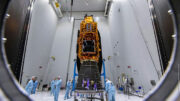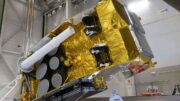Orbital Transfer Vehicle Propulsion System Market Report 2024–2040 Featuring Aerojet Rocketdyne, Busek, Bellatrix Aerospace, IHI Aerospace, CASC, Safran, Exotrail, Dawn Aerospace, OKB Fakel, and Others
The orbital transfer vehicle propulsion system market is rapidly expanding, driven by growing satellite deployment needs and inter-orbital transportation missions. The market includes various propulsion technologies like chemical thrusters, electric propulsion, and hybrids, essential for precise space maneuvers. Companies such as Astra Space, Exotrail, and Dawn Aerospace are pivotal in advancing this sector. Increased government and private sector investments are propelling technological progress, particularly in electric thrusters, known for efficiency and reliability in space missions. As space exploration demands escalate, this market is poised for significant growth and innovation.
Dublin, Oct. 13, 2025 (GLOBE NEWSWIRE) — The “Orbital Transfer Vehicle Propulsion System Market – A Global and Regional Analysis: Focus on Subsystem and Country Analysis – Analysis and Forecast, 2024-2040” report has been added to ResearchAndMarkets.com’s offering.
The orbital transfer vehicle propulsion system market includes a range of propulsion technologies such as chemical thrusters, electric propulsion, and hybrid systems that are essential for precise orbital maneuvers and vehicle transfers in space. This market has been fueled by the increasing demand for efficient and reliable propulsion systems to support growing satellite deployment and inter-orbital transportation missions. Innovations in propulsion technologies, including improved fuel efficiency and lightweight propulsion components, address the need for enhanced performance and extended mission durations.
The orbital transfer vehicle propulsion system market is highly competitive, with leading companies such as Astra Space, Exotrail, and Dawn Aerospace driving technological progress. Additionally, rising investments from government space agencies and private space enterprises to advance orbital transfer capabilities are shaping market dynamics. As a result, the orbital transfer vehicle propulsion system market is rapidly evolving to meet the challenges of complex space missions.
The orbital transfer vehicle propulsion system market has been witnessing steady growth driven by increasing demand for reliable and efficient propulsion technologies essential for orbital transfer missions. Orbital transfer vehicle propulsion systems enable precise maneuvering and transfer of payloads between different orbits, which is critical for satellite deployment and space logistics.
The market has been advancing rapidly due to innovations in propulsion technologies such as chemical thrusters, electric propulsion, and hybrid systems. These technological improvements offer enhanced fuel efficiency, greater thrust-to-weight ratios, and increased mission adaptability compared to traditional propulsion methods. Furthermore, rising investments from government space agencies and private aerospace companies are accelerating the development and adoption of orbital transfer vehicle propulsion system solutions globally. As orbital transfer missions become more frequent and complex, the orbital transfer vehicle propulsion system market is expected to expand significantly, fostering growth in the space transportation sector and related industries.
Electric Thruster to Dominate the Orbital Transfer Vehicle Propulsion System Market (by Subsystem)
Based on the subsystem, the orbital transfer vehicle propulsion system market is primarily driven by electric thrusters, which are expected to lead the market due to their efficiency and suitability for precise orbital maneuvers. The electric thrusters segment was valued at $187.2 million in 2024 and is projected to reach $177.5 million by 2040, reflecting sustained demand. Continuous advancements in electric propulsion technology, growing investments in space missions, and the need for reliable, fuel-efficient orbital transfer vehicle propulsion system solutions contribute to the prominence of this segment throughout the forecast period.
Recent Developments in the Orbital Transfer Vehicle Propulsion System Market
- In March 2025, a.i. Solutions utilized its FreeFlyer software to plan and analyze deep space missions, showcasing the critical role of AI in optimizing orbital transfer vehicle propulsion system operations and mission trajectories.
- In December 2022, SmallSpark Space Systems secured funding from the U.K. Space Agency to develop the S4-SLV space tug. The integration of AI-powered MooreAI software aims to enhance predictive analytics for orbital transfer vehicle propulsion system planning and performance, improving reliability and cost efficiency while supporting flexible space logistics.
- In March 2025, India’s Larsen & Toubro (L&T) announced a partnership with Hindustan Aeronautics Limited (HAL) to assemble the country’s first privately built Polar Satellite Launch Vehicle (PSLV). This initiative supports the advancement of indigenous orbital transfer vehicle propulsion system capabilities, aligning with India’s goal to increase private sector involvement and strengthen commercial space infrastructure.
- In December 2024, HyImpulse introduced the HyMOVE orbital transfer vehicle propulsion system, featuring environmentally sustainable hybrid propulsion technology designed to deliver cost-effective and eco-friendly space operations for both commercial and governmental customers.
- In November 2024, Bellatrix Aerospace launched its innovative water-based orbital transfer vehicle propulsion system, targeting a reduction in handling costs by over 60% compared to traditional hydrazine propulsion, thereby promoting cleaner and more sustainable satellite operations.
Key Market Players and Competition Synopsis
The orbital transfer vehicle propulsion system market is dominated by several prominent companies driving innovation and market expansion. Leading firms such as Astra Space, Exotrail, and Dawn Aerospace provide advanced propulsion solutions specifically designed for orbital transfer vehicle applications. These key players emphasize improving propulsion efficiency, durability, and operational safety to meet the demands of space missions. The competition within the orbital transfer vehicle propulsion system market is intense, with companies investing heavily in research and development to introduce state-of-the-art propulsion technologies. Market dynamics are influenced by ongoing advancements in propulsion system design and materials, enhancing performance in the space environment.
As demand for orbital transfer missions rises, companies are broadening their product portfolios and increasing their global presence to secure contracts with government space agencies and private sector organizations. Continuous technological progress in propulsion systems is expected to intensify competition and stimulate further innovation in the orbital transfer vehicle propulsion system market.
Some prominent names established in this market are:
- Aerojet Rocketdyne
- Busek Co.
- Momentus Inc.
- Bellatrix Aerospace
- IHI Aerospace
- CASC (LIP Institute)
- Safran (Airbus Safran Launchers)
- Exotrail
- Dawn Aerospace
- OKB Fakel
- KB KhIMMASH (Isaev Bureau)
Key Topics Covered:
Market Overview
- Strategic Partnerships and Collaborations in the Thruster Pump Ecosystem for Orbital Transfer Vehicles
- Technological Innovations and Trends in Thruster Pump Design
- Comparative Overview of Key Commercial Orbital Transfer or Maneuvering Vehicles
Global Orbital Transfer Vehicle Propulsion System Market (by Subsystem)
- Demand Analysis of Orbital Transfer Vehicle Propulsion System Market (by Subsystem), Value and Volume Data
- Chemical Thruster
- Propellant Tank
- Pump
- Valve
- Electric Thruster
- Propellant Tank
- Pump
- Cold Gas Thruster
- Gas Storage Tank
- Propulsion Chamber/Nozzle
- Pump
- Hybrid Thruster
- Propellant Tank
- Propulsion Chamber/Nozzle
- Pump
Global Orbital Transfer Vehicle Propulsion System Market (by Region)
Thruster and Regulatory Analysis
- Analysis of Thrusters (by Application)
- Hybrid Thruster
- Maneuvering and Attitude Control during Orbital Transfer
- Orbital Insertion and Correction Maneuvers
- Rendezvous, Docking, and Proximity Operations
- Fuel Optimization and Efficiency Management
- Station Keeping and Collision Avoidance
- Cold Gas Thruster
- Fine Attitude and Position Control in Orbit
- Emergency Abort and Rapid Response Maneuvers
- Chemical Thruster (Hot and Warm Gas)
- Precise Orbital Insertion and Trajectory Correction
- Orbital Altitude Adjustment and Thrust Modulation
- Roll Control and Dynamic Stabilization during Transfer
- Electric Thruster
- Primary Propulsion for Deep-Orbit Maneuvers
- Attitude Control for Micro-Adjustment in Orbit
- Long-Term Station Keeping and Post-Transfer Stabilization
- Regulatory Analysis (by Country)
- U.S.
- International Traffic in Arms Regulations (ITAR)
- U.S. Munitions List (USML)
- Export Control Classification Number (ECCN)
- NASA-STD
- U.K.
- The Space Industry Regulations 2021
- European Space Agency (ESA) Industrial Policy Committee
- European Cooperation for Space Standardization/Slovenian Institute for Standardization (SIST)
- France
- Centre National D’Etudes Spatiales (CNES)
- Germany
- Germany Federal Office of Economics and Export Control (BAFA)
- Regulation (EU) 2021/821 – Dual-Use Export Controls
- India
- Indian Space Policy 2023
- China
- China Space Standard System
- Russia
- The Russian Federation Federal Law
- GOST R 52925-2018
Key Customer Information
Growth Opportunities and Recommendations
- Advancements in Propulsion Systems and Material Science for Next-Generation OTV Engines
- Integration of AI-Driven Predictive Analytics for Mission Planning and Operational Efficiency
- Expansion in Emerging Orbital Transfer and Commercial Space Infrastructure Markets
- Development of Eco-Friendly and Sustainable OTV Designs for Long-Duration Missions
- Collaborative Partnerships for Enhanced Simulation, Testing, and Certification Capabilities
Source: Exotrail









Be the first to comment on "Orbital Transfer Vehicle Propulsion System Market Report 2024–2040"